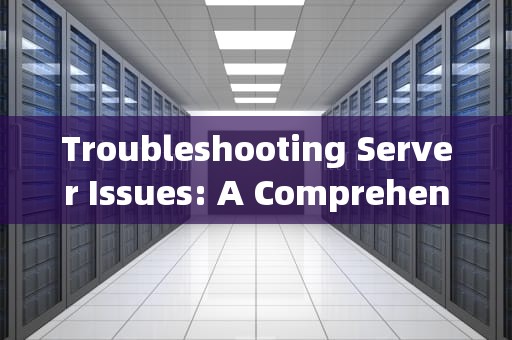When it comes to running a website or an application, encountering server problems is almost inevitable. These issues can range from minor inconveniences to severe disruptions that bring your operations to a halt. Understanding how to troubleshoot and resolve these problems is crucial for maintaining the health of your online presence. This article will provide you with a comprehensive guide on dealing with common server issues in English.

Common Server Problems and Their Symptoms
1、Server Overload
Symptom: Slow response times, timeouts, or complete unavailability of the website.
Cause: Too many requests being processed simultaneously, insufficient resources (CPU, RAM), or lack of bandwidth.
2、Database Issues
Symptom: Error messages related to database connectivity, queries not executing as expected, or data corruption.
Cause: Incorrect query syntax, lack of indexing, server misconfiguration, or hardware failure.
3、Network Connectivity Problems
Symptom: Intermittent loss of connectivity, slow data transfer rates, or complete disconnection.
Cause: Faulty network equipment, misconfigured firewall settings, or ISP issues.
4、Software Bugs or Conflicts
Symptom: Unexpected behavior, crashes, or specific features not working correctly.
Cause: Outdated software, compatibility issues between different applications, or corrupted files.
5、Security Breaches
Symptom: Unusual activity logs, unexpected changes to files or configurations, or notifications from security systems.
Cause: Hacking attempts, malware infections, or unpatched vulnerabilities.
Step-by-Step Troubleshooting Guide
1、Identify the Problem
- Check server logs for error messages or unusual patterns.
- Use monitoring tools to pinpoint the exact time and nature of the issue.
2、Check Server Resources
- Monitor CPU, memory, and disk usage to ensure they are within acceptable limits.
- If overloaded, consider upgrading your plan or optimizing your code and queries.
3、Verify Network Connectivity
- Ping your server and other critical services to check for connectivity.
- Test the network configuration and look for any misconfigurations or outages.
4、Examine Database Performance
- Review slow query logs and optimize them where necessary.
- Ensure proper indexing and consider scaling your database if needed.
5、Review Software and Configurations
- Update all software to the latest versions to fix bugs and security holes.
- Check configuration files for errors and ensure compatibility between different components.
6、Conduct Security Audits
- Run virus scans and check for malware or unauthorized access attempts.
- Apply security patches and follow best practices for securing your server.
7、Restart Services
- Sometimes a simple restart of the affected service or the entire server can resolve temporary glitches.
8、Consult Documentation and Community Forums
- Refer to official documentation for troubleshooting steps and known issues.
- Engage with community forums and seek advice from experienced professionals.
9、Contact Support
- If the problem persists and you are unable to resolve it, contact your hosting provider's support team for assistance.
Preventative Measures
To minimize the occurrence of server problems, consider implementing the following preventative measures:
- Regularly update your software and apply security patches.
- Perform routine backups of your data and configurations.
- Monitor your server's performance and set up alerts for potential issues.
- Conduct periodic security audits and vulnerability assessments.
- Optimize your website's code and queries for better performance and efficiency.
- Have a disaster recovery plan in place in case of unexpected issues arise.
Encountering server problems can be stressful, but with a systematic approach to troubleshooting and preventative maintenance, you can minimize downtime and keep your online services running smoothly. By understanding the common causes of symptoms of server issues, staying proactive about maintenance, and knowing when to seek help, you can effectively manage any challenges that come your way. Remember, preparation and knowledge are your best tools in ensuring the reliability and security of your server infrastructure.
随着互联网的普及和信息技术的飞速发展台湾vps云服务器邮件,电子邮件已经成为企业和个人日常沟通的重要工具。然而,传统的邮件服务在安全性、稳定性和可扩展性方面存在一定的局限性。为台湾vps云服务器邮件了满足用户对高效、安全、稳定的邮件服务的需求,台湾VPS云服务器邮件服务应运而生。本文将对台湾VPS云服务器邮件服务进行详细介绍,分析其优势和应用案例,并为用户提供如何选择合适的台湾VPS云服务器邮件服务的参考建议。

工作时间:8:00-18:00
电子邮件
1968656499@qq.com
扫码二维码
获取最新动态
